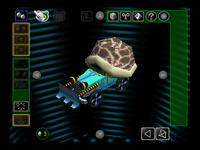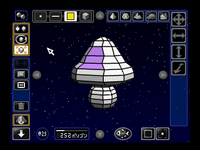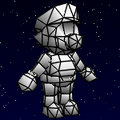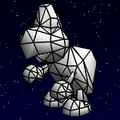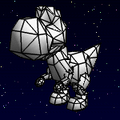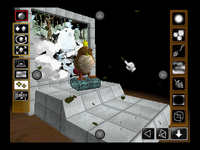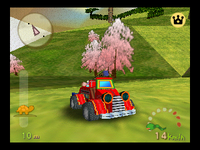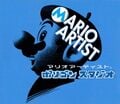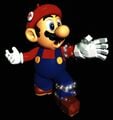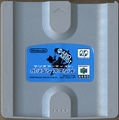Mario Artist: Polygon Studio
The title of this article is from the English Super Mario Bros. Encyclopedia, which reportedly sourced some names from fan wikis.
If a higher-priority source is found, then the article should be moved to the new title.
| Mario Artist: Polygon Studio | |
|---|---|
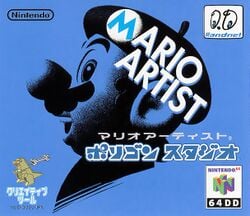
| |
| Developers | Nintendo R&D 1[1] Nichimen Graphics |
| Publisher | Nintendo |
| Platform | Nintendo 64DD |
| Release date | |
| Genre | Creative |
| Mode | Single player |
| Format | Nintendo 64DD:
|
| Input | Nintendo 64:
|
| Serial code | NUD-DMGJ-JPN |
Mario Artist: Polygon Studio is the fourth and final game released in the Mario Artist series and overall Super Mario franchise on the Nintendo 64DD, released in Japan on August 31, 2000.[2] The game allows players to construct and render 3D polygons, then texture them, and paint them. The player can also assemble models from pre-made or player-made parts and use them to explore a 3D world called the Jikken World and find newer, more effective parts. Along with this, other minigames can be played.
Gameplay[edit]
Controls[edit]
| Action(s) | Input(s) |
|---|---|
| Move cursor Adjust blocks (when selected) |
|
| Select buttons and blocks Advance page |
|
| Rotate or Zoom into a creation Return page |
|
| Move cursor to exit button | |
| Undo | |
| Move the screen | |
| Act as the |
1 - Can be configured in the options menu
Modes[edit]
Mario Artist: Polygon Studio is primarily a 3D-modelling game, divided in two main modes: Kantan ni Tsukuru (かんたんにつくる, "Creating Easily") and Pro e no Michi (プロへのみち, "Road to Pro"). Kantan ni Tsukuru is geared towards beginners, only allowing players to use pre-made blocks to create works. Pro e no Michi, conversely, allows players to model their own blocks in a simple 3D modeling program, in addition to the pre-made blocks. They are then able to use those block works in various minigames and side modes. Pro e no Michi is divided in three modes, of which the first one, Block Dome, is largely equivalent to the Kantan ni Tsukuru main mode.
The Gallery (ギャラリー, gyararī) allows the player to view their saved creations.
Block Dome[edit]
The Block Dome (ブロックドーム, burokku dōmu) is a mode in Pro e no Michi. In it, players can create Block Sakuhin (ブロック作品, burokku sakuhin, "block creations") using pre-made blocks. Players are able to resize, rotate and move blocks in order to build creations. Block can be from one of five categories:
- Parts Blocks (パーツブロック, pātsu burokku): Basic blocks that act as the body of the build.
- Animation Blocks (アニメーションブロック, animēshon burokku): Animated blocks that move in certain ways.
- Sound Blocks (サウンドブロック, saundo burokku): Blocks that continuously emmit sounds.
- ? Blocks (?ブロック, ? burokku): Bonus blocks that can be used as decoration on a creation. More are unlocked by finding them in Jikken World.
- Dōryoku Blocks (どうりょくブロク, dōryoku burokku, "Power Blocks"): Blocks that act as wheels or legs, allowing creations to move. More are unlocked by finding them in Jikken World.
From Block Dome, players are able to take their creations on two side modes: Chotto Kyūkei (ちょっときゅうけい, "Quick Break") and Jikken World (じっけんワールド, jikken warūdo, "Experimental World"). In Chotto Kyūkei, players can play two minigames, Go Go Park and Sound Bomber.
Modeler Rocket[edit]
In the Modeler Rocket (モデラーロケット, moderā roketto) mode, players are able of creating their own blocks, called 3D Sakuhin (3D 作品, "3D creations"), by utilizing a basic 3D modeling software capable of cutting, extruding, adding bevels and other functions. Players can select from various base meshes to start with, such as cubes, cyllinders, animals and houses, as well as other models such as Mario, Yoshi and Koopa Troopa from Super Mario 64.
The mode also features a number of tutorial videos showcasing different objects being modelled with the editor's features.
Objects created in this mode can be imported into Mario Artist: Talent Studio as props for movies.
マリオ
(Mario)ノコノコ
(Koopa Troopa)ヨッシー
(Yoshi)
Stage UFO[edit]
The Stage UFO (ステージUFO, sutēji UFO) mode is the last mode accessed from Pro e no Michi. In it, players can position their creations on pre-made 3D stages, with customizable backgrounds and lighting. They can also overlay special effects such as rain or falling leaves on top of the scenery. They can then access the chosen scenery from the Pro e no Michi menu for observation or taking photos.
Go Go Park[edit]
Go Go Park (ゴーゴーパーク, Gō Gō Pāku) is one of the two minigames found in the Block Dome. In it, the player must "wind up" their model (by pressing ![]() or moving the mouse forward) and try to get them to stop as close to the edge of a cliff as possible without going over. The minigame features three stages of difficulty. The first stage takes place on a grassy plains and the layout is a straight line. The second stage takes place on a fiery lava landscape, with the layout now having an incline. The third stage takes place in a starry night landscape and its layout features a slope going up and down in the middle. After beating all three stages, they repeat in order.
or moving the mouse forward) and try to get them to stop as close to the edge of a cliff as possible without going over. The minigame features three stages of difficulty. The first stage takes place on a grassy plains and the layout is a straight line. The second stage takes place on a fiery lava landscape, with the layout now having an incline. The third stage takes place in a starry night landscape and its layout features a slope going up and down in the middle. After beating all three stages, they repeat in order.
The minigame serves as a predecessor to the minigame Chicken Race in WarioWare, Inc.: Mega Microgame$!
Sound Bomber[edit]
Sound Bomber (サウンドボンバー, Saundo Bonbā) is the other minigame found in Block Dome. It is a simple predecessor to the WarioWare series' format, featuring various quick challenges involving their creation the player must complete in quick succession by utilizing simple controls. The minigame has three levels of difficulty. After three mistakes, the minigame ends.
Jikken World[edit]
- Main article: Jikken World
Jikken World is a side mode accessed from the Block Dome. In it, the player can control their creations and drive them around a series of worlds, finding Dōryoku Blocks and ? Blocks along the way. These blocks can then be added to the player's creations, allowing them to explore further. Each Dōryoku Block added on the vehicle, has different stats such as speed and traction on snow, sand and thorny terrain or maximum altitude. By having different types of blocks, the vehicle can have separate walking, driving, swimming and flying modes. Spread around Jikken World are a series of hints written on slices of bread by Udetate and Banzāi, giving advice on how to control the vehicle, as well as secrets about the world itself.
Staff[edit]
- Main article: List of Mario Artist: Polygon Studio staff
Mario Artist: Polygon Studio was directed by Hirofumi Matsuoka, who would go on to direct WarioWare, Inc.: Mega Microgame$!, a game which follows the same format of quick microgames as the Sound Bomber minigame.
Gallery[edit]
Artwork[edit]
Mario artwork
Screenshots[edit]
The Hajime Terminal in the Jikken World
The entrance to Porigoneshia
A flying egg pursuing the player
A tube creature in the overworld
Miscellaneous[edit]
A photo of the Mario Artist series demonstration event in Nintendo Space World '99, which the game was demonstrated
References to other games[edit]
- The Baby Face from this game can be seen floating in the background of the model creation menu, and makes its signature noise when clicked on.
- As with all other Mario Artist titles, a dog's head serves as the "Undo" icon, a reference to Undodog.
- When starting up the game, there is a chance that a scene of Udetate and Banzāi doing aerobics will play, just like in this game. They also appear in Jikken World leaving behind messages, and can be eventually collected and used as blocks by the player.
- Untextured versions of Mario, Yoshi and Koopa Troopa's models from this game can be loaded in the Polygon Editor.
- A part called the Power Star can be found in the Jikken World mode, which makes all Power Block parts perform like their most superior counterparts.
- An untextured version of Kirby's model from this game can be found in the Polygon Editor.
References in later games[edit]
- The concept of microgames originated from Polygon Studio's Sound Bomber mode. The introduction stage taking place inside a boombox is a direct reference to Sound Bomber. Additionally, all of the Sound Bomber microgames appear in this game, under different names and with different graphics and controls:
- JUMP appears as Crazy Cars.
- BLOCK appears as Diamond Dig.
- SHOOT appears as Repellion.
- ROULETTE appears as Wario Whirled.
- BASEBALL appears as Batter Up.
- FLIES appears as Mario Paint: Fly Swatter.
- RACE appears as Hectic Highway and Racing 112.
- MAZE appears as Maze Daze.
Names in other languages[edit]
| Language | Name | Meaning | Notes |
|---|---|---|---|
| Japanese | マリオアーティスト ポリゴン スタジオ[3] Mario Ātisuto: Porigon Sutajio |
Mario Artist: Polygon Studio |
References[edit]
- ^ Kikizo (April 7, 2006). Nintendo R&D1 Interview. Kikizo Archives. Retrieved October 26, 2025.
- ^ a b Sakai, Kazuya (Ambit), et al. (October 19, 2015). 『スーパーマリオブラザーズ百科: 任天堂公式ガイドブック』(Super Mario Bros. Hyakka: Nintendo Kōshiki Guidebook). Tokyo: Shogakukan (Japanese). ISBN 978-4-09-106569-8. Page 244.
- ^ Box art
External links[edit]
| Mario Artist: Polygon Studio | |
|---|---|
| Characters | Baby Face • Udetate and Banzāi |
| Objects and obstacles | Block • Dash no Panel • Flying egg • Jump no Panel • Shokupan • Tube creature |
| Locations | Hajime Terminal • Henkyō Inferno • Kōkōdo Paradiso • Kūchū Teien Porigonā • Porigoneshia |
| Side modes | Go Go Park • Jikken World • Sound Bomber |
| Other | Staff |
| Nintendo 64 games | |
|---|---|
| Super Mario franchise | Super Mario 64† (1996) • Mario Kart 64† (1996) • Mario no Photopi (1998) • Mario Party (1998) • Mario Golf (1999) • Mario Artist: Paint Studio* (1999) • Mario Party 2 (1999) • Mario Artist: Talent Studio* (2000) • Mario Artist: Communication Kit* (2000) • Mario Tennis (2000) • Paper Mario† (2000) • Mario Artist: Polygon Studio* (2000) • Mario Party 3 (2000) • Dr. Mario 64† (2001) |
| Donkey Kong franchise | Diddy Kong Racing (1997) • Donkey Kong 64 (1999) |
| Yoshi franchise | Yoshi's Story† (1997) |
| Crossovers | Super Smash Bros.† (1999) |
